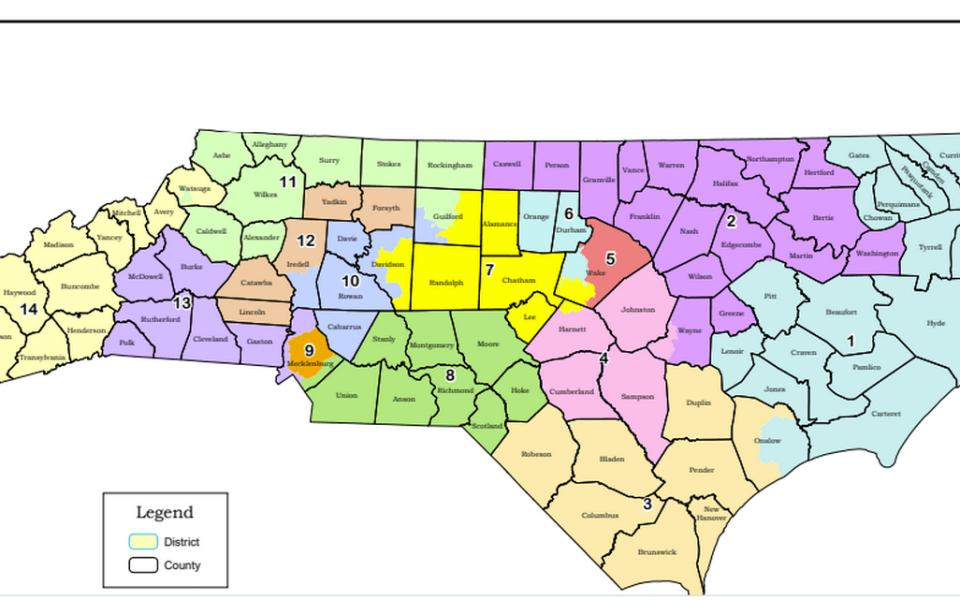North Carolina’s new district map has drawn quite a few lawsuits. Photo courtesy of the North Carolina General Assembly.
Correction (Nov. 19): This article previously stated that Democracy NC had filed a lawsuit against the new North Carolina state maps. Democracy NC has been supporting groups who are filing lawsuits but has not been named plaintiff on any current redistricting cases.
Of all the new US Congressional maps for the 2022 election cycle, North Carolina’s are by far the worst.
On Nov. 4, the Republican-led NC General Assembly approved the newly redrawn district maps for the upcoming 2022 elections. This means that some voters who had previously voted in one district may end up across the line in another.
Currently, North Carolina’s 13 congressional districts are represented by eight Republicans and five Democrats, even though the state has historically been split evenly regarding the political parties of voters. This next election is likely to tip the scales even further to the right, as the new maps have been redrawn using cracking and packing in the three largest metro areas in the state.
Packing is when voters of similar voting pattern are put together in one district. This is what has happened in the city of Raleigh, which gives District 5, a 65-32 Democrat advantage, and Durham County, which is folded into District 6 that is 71 percent Democrat. Charlotte becomes District 9, also 71 percent Democrat, while the rest of Mecklenburg is cracked off into District 13 (59 percent Republican) and District 8 (57 percent Republican).
Cracking is when one group of like-minded voters is split up into many to include more voters of the opposite party so that the first party does not have as much power. This is what has happened in Guilford County, where Greensboro has been cracked into three separate Congressional districts
Rep. Destin Hall (R-Caldwell), who worked on the state House maps, said, “We focused only on traditional criteria like keeping counties and cities whole. North Carolinians can be proud of what has been the most transparent redistricting process in state history.”
Public input has always been an important part of redrawing state maps, but Democracy NC Communications Manager Joselle Torres says the public has had a lot less of a say in recent years compared to years prior.
For example, while 63 public hearings were available for the public to give their input in 2010, there were only 13 in 2020. In the two weeks since the maps were drawn, only two hearings were available and the public only had four days to analyze them before the hearings.
The NC NAACP and Common Cause NC, with support from organizations such as Democracy NC, have already filed lawsuits claiming all three newly drawn maps are unfair or illegal.
“The main issue in one of the lawsuits is that legislators did not use any racial data in creating these maps,” said James Pearce, the organizing manager at Represent Us, an organization dedicated to rooting out systemic inequality in politics. “They’re required to create a number of majority-minority districts. This is especially bad around Greensboro, where African-American members of the Senate are going to be drawn into more competitive districts and we’re going to see a loss of BIPOC representation.”
The new state Senate map packs Winston-Salem into District 32 and cracks Guilford County into three districts.
Represent Us worked with the Princeton Gerrymandering Project to grade the North Carolina maps that were submitted for approval. Each map was graded on partisan fairness, competitiveness and geographic features. The project works by taking computer simulations of the redistricting plans and comparing the official maps.
All three maps got Fs overall and Fs for partisan fairness, meaning that as the maps are now, few Republican candidates will have to compete to keep their seats. Some of the other state maps have Fs, such as Texas’ Congressional and Senate maps and Ohio’s state house maps, but no other state has a failing grade for all three maps as of yet.
“Instead of voters choosing their politicians, we have politicians choosing their voters,” said Pearce. “When that happens, the only people these politicians have to listen to are the extreme ends of their base.”
In the last few weeks, Torres and others at Democracy NC have been working to make sure voters’ comments are interpreted correctly by the General Assembly.
“The biggest thing for us is representing the people that the North Carolina General Assembly has shut out,” said Torres. “When we think about the candidate filing deadline for Dec. 6, how can we ensure bad maps don’t lead to bad elections?”
Greensboro representative Pricey Harrison, of District 61, is one of the few Democrats who feels secure in her seat. She says, however, that this may not be the best thing.
“We’ve got six safe seats, but it’s better for the public if you have competitive seats,” she said. “There will be a primary, and this is the problem with this gerrymandering, is that the election is going to be made in the primary. You need to compromise and work together.”
Harrison has been fighting for fair elections since she took office in 2004. She says that if it were up to her, she would have an independent redistricting commission redraw the election maps rather than current representatives.
“You can’t forget the info you have in your head about where the Republican precincts are,” she said. “It would be better for the public because you wouldn’t be trying to protect your incumbency.”
Candidate filings are due by Dec. 6, 2021. The primaries will be held on March 8, 2022 and the general elections on Nov. 8, 2022.
Join the First Amendment Society, a membership that goes directly to funding TCB‘s newsroom.
We believe that reporting can save the world.
The TCB First Amendment Society recognizes the vital role of a free, unfettered press with a bundling of local experiences designed to build community, and unique engagements with our newsroom that will help you understand, and shape, local journalism’s critical role in uplifting the people in our cities.
All revenue goes directly into the newsroom as reporters’ salaries and freelance commissions.


Leave a Reply